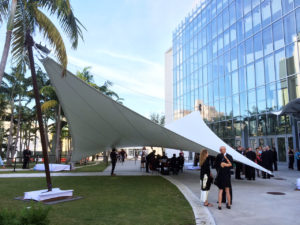
The first name of Frei Otto, a pioneer in tensioned fabric architecture born in 1925 in Siegmar, Germany, translates to “free” in his native tongue. The gifted architect developed his vision of lightweight architecture following stints as a stonemason for his parents (both sculptors), a pilot in WWII, a prisoner of war charged with camp architecture and a devotee of organic, earth-based forms and materials.
Otto died on March 9, 2015, at age 89. He received the Pritzker Architecture Prize, often called architecture’s Nobel prize, posthumously on May 16, 2015, and the Hyatt Foundation, created by the Pritzker family of Chicago, wanted a special venue for the ceremony.
Birdair Inc., Buffalo, N.Y., developed an open-air hyperbola formed by 1,000 square feet of tensioned PVC membrane to resemble an iconic 1955 Frei Otto canopy design.
“We’re proud to be part of the celebration of Frei Otto’s life work,” says David Capezzuto, Birdair director of business development. “He was a pioneer in the field in which we strive to continue to innovate.”
Birdair installed the graceful, soaring canopy at the New World Center in Miami Beach, Fla., a building design by 1989 Pritzker Prize laureate Frank Gehry.
Otto created memorable tensioned architecture that left indelible impressions: the Olympic Park for the 1972 Summer Olympics in Munich; the German pavilion at the 1967 International and Universal Exposition (Expo 67) in Montreal, Canada; the Japan pavilion at Expo 2000 in Hannover, Germany; and the Institute for Lightweight Structures, University of Stuttgart, which Otto founded in 1958 and designed in 1967.
Read more about Frei Otto’s life and work.
 TEXTILES.ORG
TEXTILES.ORG


